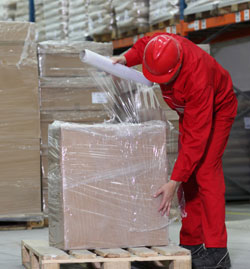
This isn't how to do it
Shrink-wrapping a pallet load has a number of advantages but these can only be secured if the wrapping process is carried out properly. In this article, we advise the best way to wrap a load and explain some of the methods and equipment available to assist with this important warehouse task.
DON'T RISK DAMAGE TO YOUR GOODS THROUGH POOR SHRINK-WRAPPING
Stretch-wrapping is a packaging technique used in the supply chain to secure goods to a pallet to help prevent damage or loss during distribution. The process involves applying layers of stretchable plastic film from a roll to the load. The term is often used interchangeably with 'shrink-wrapping' but this is actually a different process in which film is applied loosely around an item or load and then and shrunk tightly through the use of heat. The most common stretch-wrap material is linear low-density polyethylene – or LLDPE – although other types of polyethylene and PVC can also be used. Films are available in different thicknesses, or gauges, that offer variable puncture resistance and most have about 500% stretch at breaking point but are generally stretched to up to 300% in use. As well as keeping loads stable during transit, stretch-wrapping provides some protection against dust, moisture and pilferage.
"If a job's worth doing, it's worth doing well."
THE BEST WAY TO SHRINK-WRAP A PALLETISED LOAD
- Prepare the load - First, choose a sturdy pallet that is the right size for the boxes or other items you are trying to unitize. Then make sure the individual items are as close together as possible on the pallet. Any spaces between them may cause the load to shift around after you've stretch-wrapped it, making the whole process ineffective.
- Elevate the load - If you place the load to be wrapped on an elevated surface or a stack of empty pallets, it will make it considerably easier to wrap and will save your back, as you won't need to bend so far. If you set your pallet at an angle rather than square on the stack, it will be easier to include the load corners.
- Attach the film - Pull out some shrink-wrap from the roll and scrunch it together into a shape like a rope. Then simply thread this through one corner of the pallet and fold the rest of the 'rope' over it – you don't need to tie a knot, as the film adheres to itself. Before you start wrapping, ensure that the area around the pallet is clear of any obstacles to avoid the risk of tripping and be sure to walk forwards so that you are aware of any potential dangers.
- Focus on the base - Wrap around the base of the pallet, following in the same direction as you started when folding over the 'rope' in the corner. The base is important to prevent the load from slipping off the pallet, so wrap around it several times, ensuring that the edge of the film goes underneath the corners. Remember to keep the film taut as you go.
- Work your way up - Continue to wrap upwards, keeping the film stretched tightly and ensuring that each layer overlaps with the preceding one by about 50%. Don't be tempted to skimp on wrap around the middle of the load. The top of the load should be wrapped twice to ensure stability. Remember that the important factor is not the gauge of the film but the 'containment force' – this is a function of the amount of force applied as the load is rotated and the number of layers of film.
- Tidy up - When you reach the top of the load, test its stability and decide whether you need to continue wrapping back down to the base again. When the load is stable, tear the film – a pocket knife is useful – and fold the end under the edge of one of the layers on the side of the pallet. If you fail to tuck in any 'tail' of stretch-wrap, you risk tripping over it – or, worse, getting it caught on machinery such as forklifts and conveyors, causing time-consuming disruption to the supply chain.
- Consider automation - If your business grows and you find yourself or your staff spending considerable time in stretch-wrapping loads, it's probably time to consider partial or full automation of the process. There are many types of equipment available to take the strain out of this vital task including pole wrappers, rotary arm wrappers, turntable wrappers and orbital wrappers.
WE'VE GOT PALLET DELIVERIES ALL WRAPPED UP…
If you've got a palletised consignment that needs delivering or collecting from any of our 13 European destinations, let National Pallets take the strain – call us, we're a friendly bunch on 0345 260 1086 (calls charged at local rate). Or book online and start earning pallet points.

